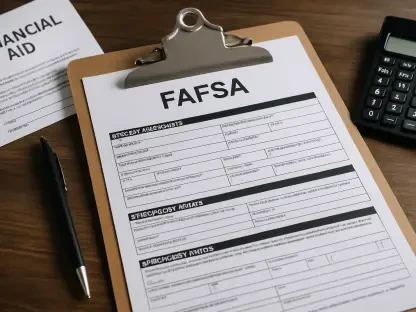Did you know that aging infrastructure in higher education across the nation carries a staggering deferred maintenance backlog estimated at nearly $1 trillion? In New York, a significant step toward addressing this crisis has been taken with a $49 million allocation through the Higher Education Capital Matching Grant Program (HECap) to 35 private colleges. This funding, recently announced by Governor Kathy Hochul, aims to revitalize campuses through critical upgrades and expansions. This roundup gathers diverse opinions, tips, and reviews from industry leaders, financial analysts, and educational administrators to explore how these grants are being utilized, the challenges they address, and what lessons can be drawn for broader application. The goal is to provide a comprehensive view of this pivotal investment and its implications for higher education infrastructure.
Diverse Views on the Impact of HECap Grants
Varied Projects and Institutional Priorities
Insights from educational administrators reveal a broad spectrum of projects benefiting from the $49 million in grants, tailored to meet specific campus needs. For instance, larger allocations like the $5 million awarded to Hobart and William Smith Colleges for a new science building contrast with smaller grants, such as the $69,800 to Maria College for technological equipment. Many administrators praise the flexibility of the program, noting that it allows institutions to address both large-scale construction and niche operational enhancements.
However, some voices in the academic community express concern over the disparity in grant sizes. Smaller colleges often struggle with systemic infrastructure issues that modest funding might not fully resolve, while larger institutions with bigger awards can tackle transformative projects. This raises questions about equity in distribution and whether the program adequately supports all recipients in achieving long-term stability.
A recurring tip from campus planners is the importance of strategic prioritization when applying for such grants. Institutions are encouraged to align their proposals with state economic goals, such as job creation or innovation hubs, to maximize their chances of securing substantial funding. This approach, they argue, ensures that projects not only benefit the college but also contribute to regional growth.
Financial Model and Collaborative Funding
Financial analysts highlight the strength of the HECap program’s 3:1 matching requirement, which transforms the state’s $49 million into a $195 million investment with institutional contributions. Projects like Clarkson University’s engineering complex upgrade and Cornell University’s new classroom space exemplify how this model enhances academic environments. Analysts commend this structure for stretching public dollars further and fostering a sense of shared responsibility.
On the flip side, some fiscal experts caution that the matching requirement can strain smaller or less financially stable colleges. If an institution cannot raise the required funds, it risks missing out on critical upgrades, potentially widening the gap between well-resourced and under-resourced schools. This perspective underscores a need for supplementary support mechanisms to ensure inclusivity in accessing grant benefits.
A practical suggestion from budget officers is for colleges to explore alternative funding sources, such as alumni donations or private partnerships, to meet matching requirements. Building a diverse funding portfolio, they note, can mitigate the financial burden and enable even smaller institutions to leverage state investments effectively for campus improvements.
Modernization in Line with Educational Trends
Industry observers point out that the grants align with modern educational demands by funding innovations like D’Youville University’s osteopathic medicine facility. This focus on cutting-edge facilities is seen as a proactive move to keep New York’s colleges competitive, especially when compared to other states where infrastructure investment lags. The emphasis on technology and specialized spaces is often cited as a draw for prospective students and faculty.
Contrasting opinions emerge regarding the sufficiency of such funding in addressing broader trends. While the grants support innovation, some educational consultants argue that they only scratch the surface of a deeper national crisis in deferred maintenance. With aging buildings still prevalent across campuses, there’s a call for more comprehensive strategies beyond periodic capital injections to ensure sustainable modernization.
A valuable tip from facilities management experts is for colleges to integrate long-term planning into their grant applications. By focusing on projects that incorporate energy efficiency or adaptable designs, institutions can future-proof their infrastructure against evolving educational needs, maximizing the impact of state support over time.
Immediate Needs Versus Sustainable Solutions
Feedback from campus operations teams emphasizes the dual focus of the grants, balancing immediate student life enhancements with the preservation of aging structures. Projects like Sarah Lawrence College’s $1.6 million experiential learning center illustrate a commitment to enriching educational experiences, while many grants also target critical repairs to prevent further deterioration of facilities.
Some policy analysts, however, draw comparisons with other states, noting that New York’s approach, while commendable, operates within a landscape of escalating maintenance costs. Reports from financial and building intelligence firms indicate that fiscal pressures often outpace available resources, suggesting that targeted grants may not fully address the scale of infrastructure deficits. This sparks debate on whether such programs are stopgap measures or part of a larger vision.
An actionable insight from infrastructure specialists is for colleges to adopt a phased maintenance strategy. By using grant funds to tackle high-priority repairs first while planning for future investments, institutions can manage limited resources more effectively, ensuring both immediate functionality and long-term campus resilience.
Lessons and Strategies from New York’s Funding Approach
Educational policy experts widely recognize the diversity of projects funded under the HECap program as a key strength, allowing for tailored solutions across different institutions. The range of investments, from recreational spaces at Albert Einstein College of Medicine to major science facilities, demonstrates a nuanced understanding of campus needs. This adaptability is often cited as a model for other states looking to support private higher education.
Another lesson lies in the effectiveness of the 3:1 matching system, which analysts describe as a powerful tool for amplifying public investment. Yet, there’s acknowledgment of the urgency to tackle infrastructure deficits more holistically, given the national backlog of maintenance needs. Some suggest that states could pair matching grants with low-interest loans or tax incentives to ease the financial load on colleges.
A practical takeaway for policymakers elsewhere is to prioritize targeted investments in high-impact areas like STEM facilities or student support spaces. By focusing on projects with measurable outcomes, such as increased enrollment or job creation, states can build a case for sustained funding while addressing pressing campus challenges in a meaningful way.
Reflecting on a Path Forward for Higher Education Infrastructure
Looking back, the roundup of perspectives on New York’s $49 million allocation to private colleges paints a multifaceted picture of progress amid persistent challenges. The insights gathered from administrators, analysts, and industry observers highlight both the transformative potential of the HECap grants and the limitations in addressing a national infrastructure crisis. Moving forward, a critical next step involves advocating for hybrid funding models that combine state grants with private sector involvement to create a more robust safety net for colleges. Additionally, fostering interstate collaboration to share best practices could amplify the impact of such initiatives, ensuring that higher education remains a cornerstone of innovation and economic vitality across the country.









